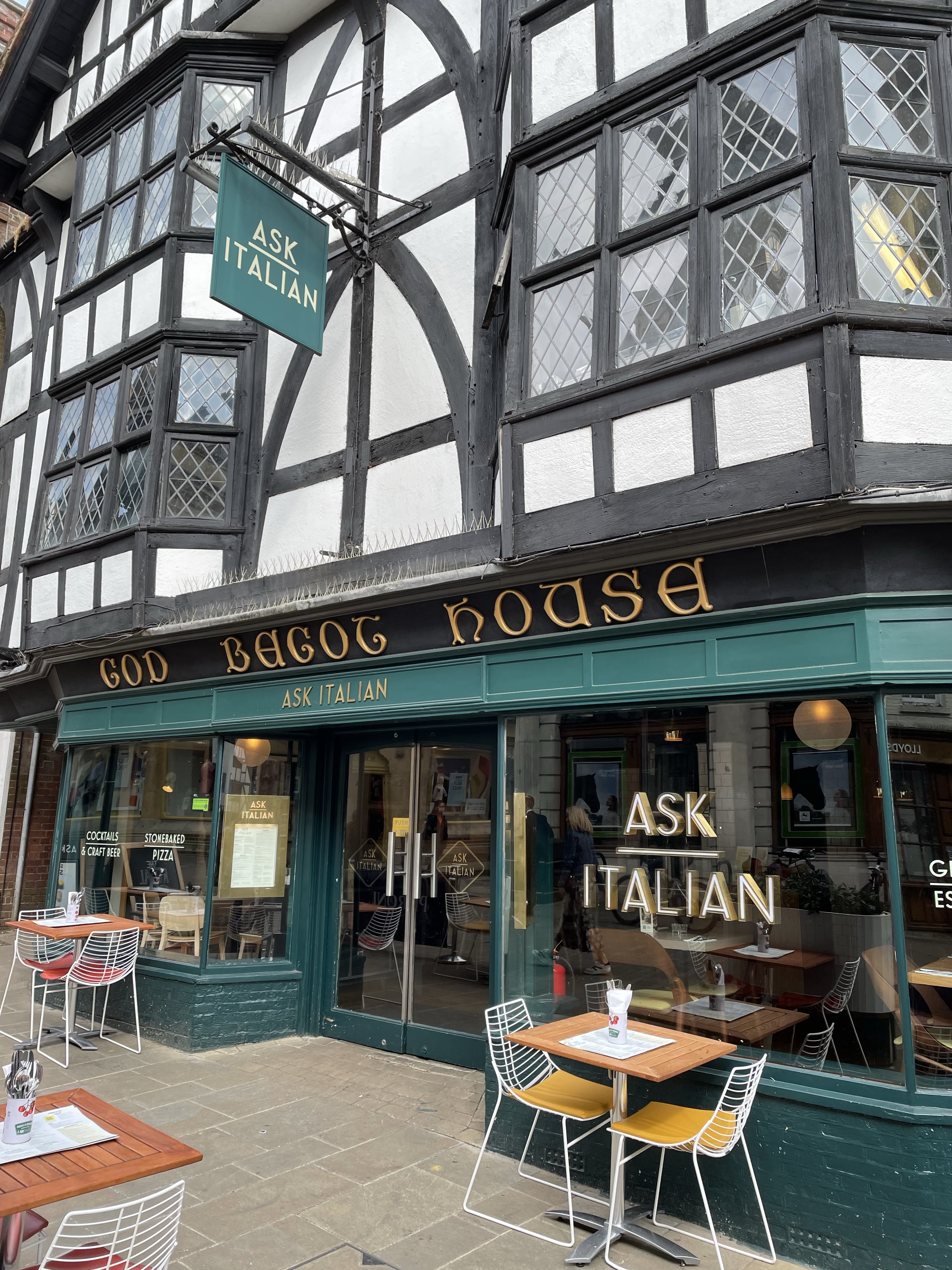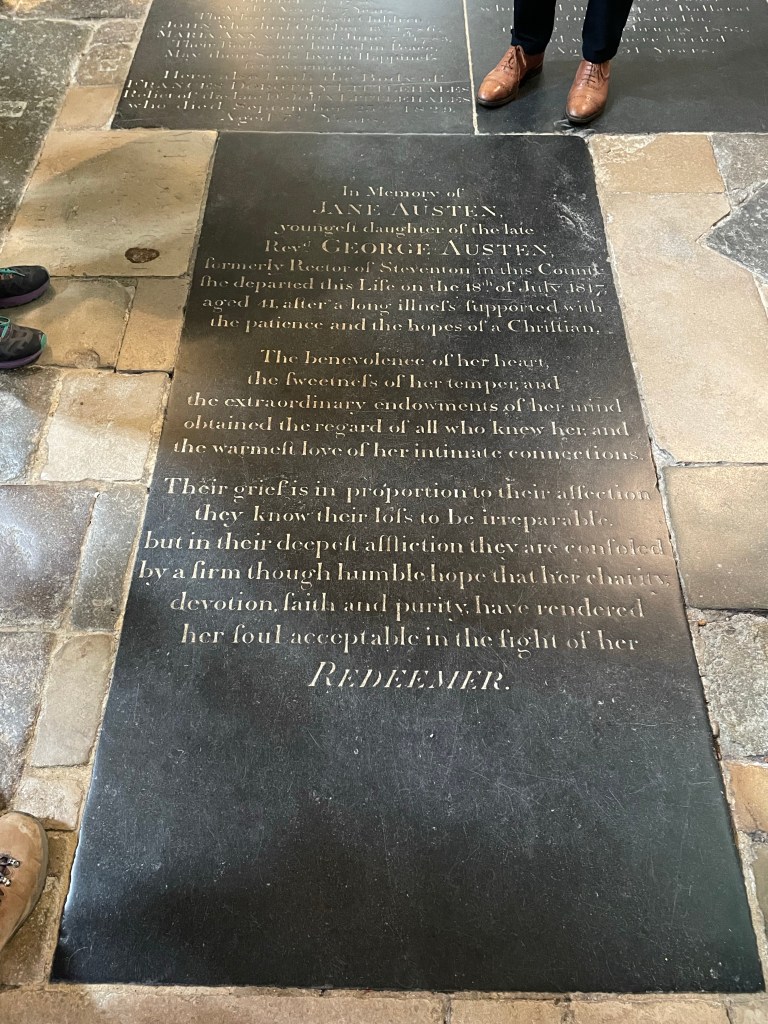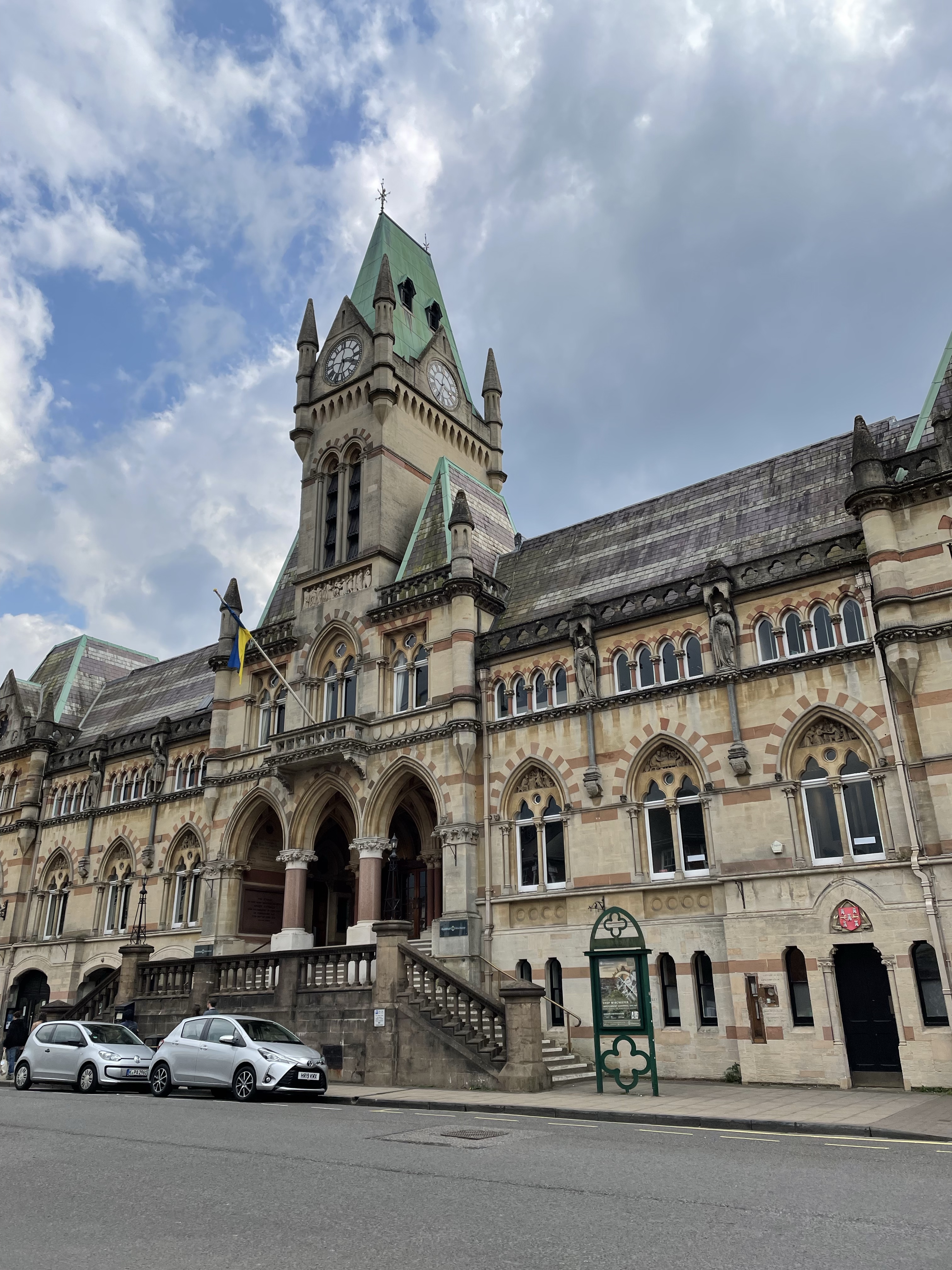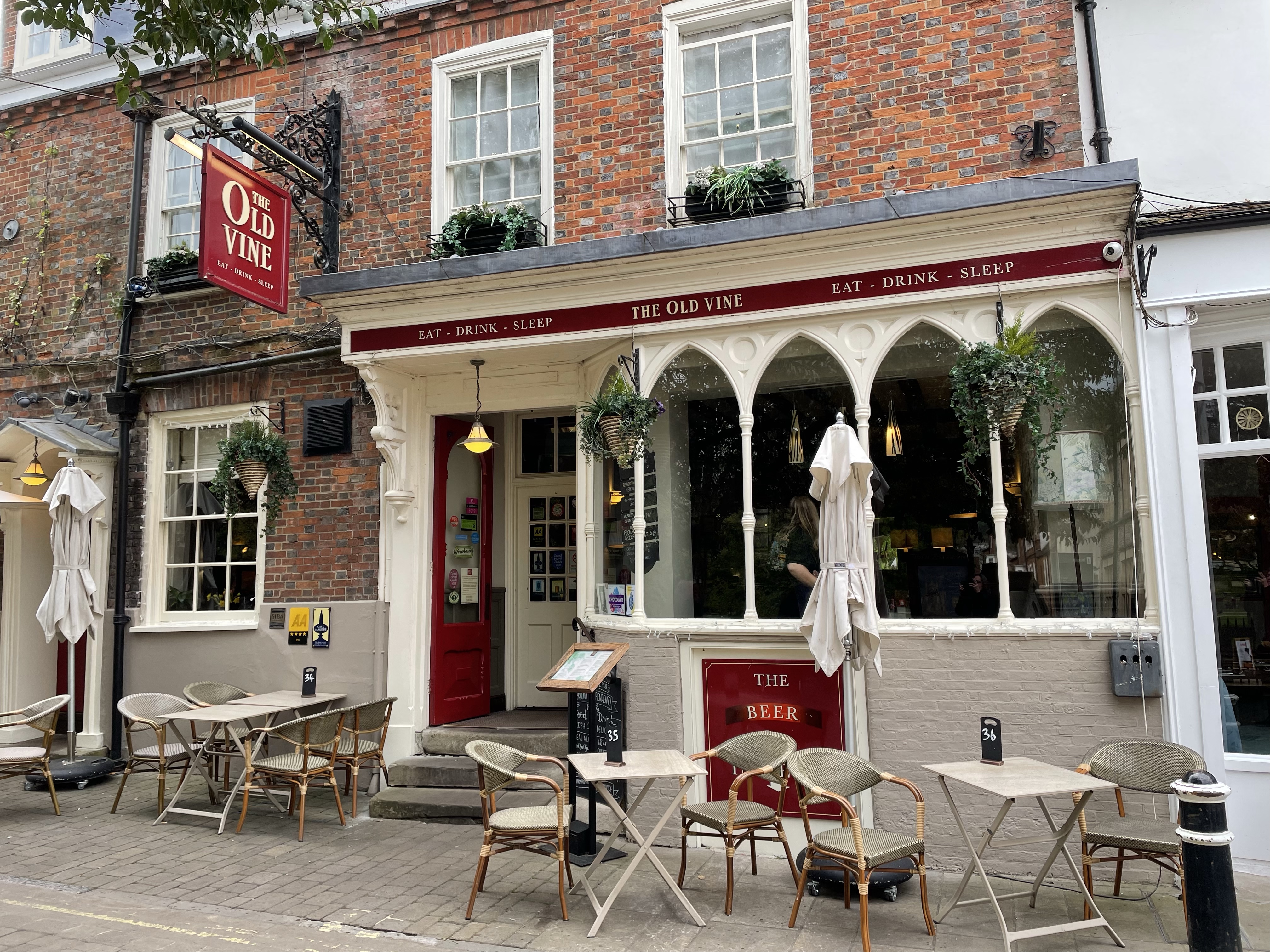Loons of the Round Table
by afatpurplefig

Tuesday announces our outing to Winchester, and its famed cathedral. We walk to Woolston station, in the first stage of a carefully-planned day. I am reminded of how much I love trains, not so much for their mechanics, as for the way they support a community at work and leisure. Social norms are reflected in public transport, in the way people share close quarters with one another, although, here, I spy nothing of particular note.

Winchester is an attractive city. Once the capital of England, it was developed from a fortified iron age settlement sometime around 150 BC. The ‘Vibrant. Ancient. Cultured.‘ slogan on the home page of the city’s website feels apt. The Starbucks-in-a-tudor-building effect is in full swing here, in historic buildings with ‘For Let’ signs and ancient lettering being passed over for the names of contemporary Italian restaurants.


A boy in a red hoodie sits on the steps of the 15th-century Buttercross Monument, on the High Street. After I whisper that he is spoiling my photo, Karen promptly asks him if he wouldn’t mind moving. I love spending time with people who don’t hesitate to ask for what they want.
I like both photos.


We make a beeline for Winchester Cathedral, sitting outside on stone benches by the graveyard for a time, in anticipation.

Our welcome attendant steers us towards a gathering of Cathedral Guides, wearing red fabric collars fixed with cathedral pins. ‘Do you feel like doing a tour, Angus?’ she asks a dapper gent, dressed in hidden tweed and brogues.
‘I’m not sure I want to take the rowdy ones‘, he replies, with a smile. I can hardly believe I am in a group that has been designated as ‘rowdy’. Here is a picture of the incredibly-dignified Angus, in the early stages of our tour.

Over the course of the next hour, my brain struggles to absorb the facts imparted via the apparently-prodigious knowledge of Angus. Dates and events flow like water. The Reformation and English Civil War, Catholics and Protestants, Normans and Saxons, the righteous feet of the pilgrims. ‘I shall learn all of this later‘, I tell myself, as I take frantic notes on my phone, from which the following comprise a part:
William conquered (I actually typed that)
Perpendicular gothic – ‘does what it says on the tin’
18 miles of oak beams
Bishops – fast track to heaven
Stampeded on horseback, shot windows
Font marble Belgium
St Nicholas dowry
Indecorous
Frescos hidden 700 years
Largest expanse mediaeval tiles England
Holy hole
Dragons, pagans
I don’t have time to complete the equivalent of a degree in English history so, when the dust settles, I am left with these takeaways:
The cathedral is a monumental architectural achievement that deserves to be worshipped on the basis of it reflecting the capacity of humanity for beauty and endeavour. It does indeed look like ‘perpendicular gothic’, hence my fondness for Angus’ quote, that it does exactly ‘what it says on the tin’.

As humans have the capacity for creation, so too have they the capacity for destruction. The limestone carvings of The Great Screen were broken up at the time of the Reformation, and the huge stained glass windows at the front of the cathedral suffered a similar fate during the English Civil War. ‘We are aghast at the destruction of treasures by Isis’, our wise guide states, ‘but we have done the same, in the name of religion and politics.’


Jane Austen’s funeral, attended by four people, took place in Winchester Cathedral, and she is buried here. After her death, her sister, Cassandra, wrote in a letter:
‘I have lost a treasure, such a sister, such a friend as never can have been surpassed. She was the sun of my life, the gilder of every pleasure, the soother of every sorrow; I had not a thought concealed from her, and it is as if I had lost a part of myself.‘
Jane’s writing was considered ‘indecorous’ for the time, so her novels were all published anonymously. It was only after her death that her brother, Henry, published them under her own name, and the Jane Austen train left the station.
Here’s to indecorousness, in women, in particular.


These tiles are really something. The largest expanse of medieval tiles in England, they have survived due to the pattern being etched into the tile and then filled with a white clay mix, as opposed to simply being painted. There is an excellent description of the tiles here, if you have a burning desire to know more. When Angus tells us about them, I want to shout for everyone to tiptoe or, better still, leave the cathedral immediately. I still don’t really understand why we were allowed to traipse all over them. I also apparently like taking pictures of my feet.
‘I was here. See my boots?‘

The pilgrims entered what was known as the ‘Holy Hole’ to worship the bones of St Swithun, indicating that Christians may not have had have a fully-formed sense of humour.

The legend of the day was William Walker, who spent six hours a day, six days a week submerged in murky water for over FIVE YEARS, shoring up the foundations of the cathedral with 26,000 bags of concrete. At the end of his working week, he would cycle 70 miles home to Croydon, where he presumably busied himself with adding to his brood of at least 11 children. I was pleased to hear it. If anyone deserved to enjoy what was left of his Sunday, it was this guy. His grave reads, ‘The diver who with his own hands saved Winchester Cathedral.’


The carvings on these oak choir stalls from the 14th century are astounding. They are attributed to one William of Lyngwode, a carpenter from Norfolk, whose work is so finely detailed, it is possible to identify the plants from their leaves. I’m not sure that surrounding Christians with imagery of dragons and pagans, in the name of reminding them of the seriousness of the battle in which they are engaged, is a solid approach. I’d like to know more about Will and his intentions.



And, finally, hearing a cellist in a cathedral is the closest I have ever come to feeling holy.

Later, as I explore the Cathedral’s website, I discover a live camera stream documenting the nesting of peregrines, and have been watching them solidly since. Winnie and William are expecting their first around the 28-29 April. I sure hope there isn’t a premature birth while I’m on my flight home, causing me to miss the big moment.
Post cathedral-worship, we wander down the High Street and take a pictures of King Elfred and the Guildhall, which stands on the site of an estate given by Elfred to his wife, Ealswith, in AD 871. ‘I love Saxons‘, Lucy whispers in excitement, darting across the road for a picture.
Everyone should visit England with an archaeology student.


‘Another day, another English pub‘ would do an injustice to The Old Vine, where we stop for lunch. I love that Col seriously contemplates getting a FEB (full English breakfast). It makes me want one too, but I settle for fish cakes and steal mussels from Lucy’s ample bowl. The food is sensational, as is this lager in the mini-matching glass of my half-pint.



After lunch, it is time for the final attraction.
The Great Hall is ‘one of the finest surviving aisled halls of the 13th century‘ and the only surviving part of Winchester Castle above ground. It boasts an impressive hammerbeam roof, a stern statue of Queen Victoria and The Long Gallery, which features a series of paintings of rather foppish-looking British noblemen.



Its primary drawcard, however, is King Arthur’s Round Table, which is inscribed with the names of King Arthur and 24 of his notable knights.
The table is enormous, measuring 5.5 metres in diameter and weighing 1200kg, and is mounted on the wall. The current paintwork has been attributed to Henry VIII (who sure did get his name about a lot during his lifetime), but the table itself has been dated to the reign of Edward I, in the late 1200s.
To be clear, this isn’t the actual round table, around which King Arthur and his knights sat, which would be difficult, given there is no tangible evidence of the existence of King Arthur himself, let alone his table. This is a copy, said to have been constructed for a festival held near Winchester to celebrate the betrothal of one of Edward’s daughters.
This makes it no less impressive.

After gasping and sighing and snapping photos, we spy a rack of children’s costumes and are drawn like bees to honey. I crouch down to take this photo of my cousins re-enacting a beheading with a coathanger, and laugh so hard, I can hardly get back up.

My English family know how to ask for what they want but, even better, they sure do know how to have fun.
The laughter is everything.
Signed: the Pope.


The perpendicular gothic is beautiful.
It sure is. Breathtaking.
Well all I can say is that Angus , our cathedral guide , was very particular in creating an atmosphere of complete silence once we were inside the cathedral. You could only speak when he invited you to do so and he wasn’t afraid of letting you know if you weren’t silent enough! He had a structural rhythm to his patter and woe betide you if you attempted to interrupt. Excellent as he was, I would like to defend the family in the use of the word ‘ rowdy ‘. Hand on heart , we were all very well behaved inside the cathedral and he should feel very lucky that he did not get an invite to witness the re-enactments at The Great Hall by the family (Colin excluded). I’m sure the description of the word ‘rowdy’ would have been replaced by sniggering hooligans! Xx
This is true. I didn’t even laugh out loud when Angus pointed out the Holy Hole…